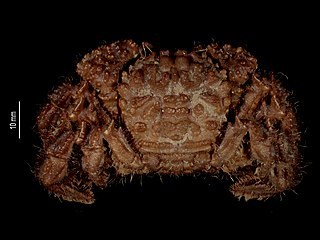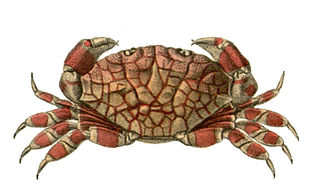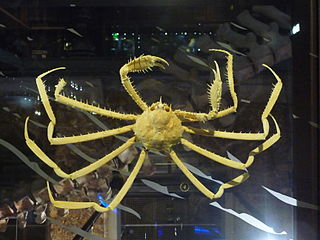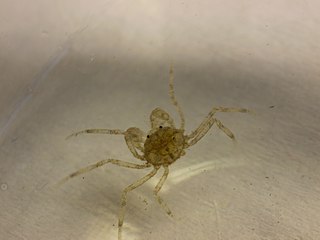
Carcharhiniformes, the Requiem sharks, are the largest order of sharks, with over 270 species. They include a number of common types, such as catsharks, swellsharks, and requiem sharks.

Xanthidae is a family of crabs known as gorilla crabs, mud crabs, pebble crabs or rubble crabs. Xanthid crabs are often brightly coloured and are highly poisonous, containing toxins which are not destroyed by cooking and for which no antidote is known. The toxins are similar to the tetrodotoxin and saxitoxin produced by puffer fish, and may be produced by bacteria in the genus Vibrio living in symbiosis with the crabs, mostly V. alginolyticus and V. parahaemolyticus.

Homolodromiidae is a family of crabs, the only family in the superfamily Homolodromioidea. In contrast to other crabs, including the closely related Homolidae, there is no strong linea homolica along which the exoskeleton breaks open during ecdysis. The family comprises two genera, Dicranodromia, which has 18 species, and Homolodromia, with five species.

Vultocinus anfractus is a species of crab, the only species in the family Vultocinidae. It has been found around the Philippines, Vanuatu and New Caledonia, and lives on driftwood. Its discovery forced a reappraisal of the relationships within the superfamily Goneplacoidea, and to the recognition of Mathildellidae, Conleyidae and Progeryonidae as separate families.

Macropodia is a genus of crabs, belonging to the family Inachidae. It contains the following species:

Leucosiidae is a family of crabs containing three subfamilies and a number of genera incertae sedis:

Paromola cuvieri is a species of crab in the family Homolidae, the carrier crabs. It occurs in the eastern Atlantic Ocean and the Mediterranean Sea, from Angola to Norway, the Northern Isles and Iceland. It is demersal, occurring at depths of 10–1,212 metres (33–3,976 ft), but it is primarily found deeper than 80 m (260 ft). It prefers areas with mud and emerging rocks, and has been observed in deep-water coral gardens and sponge aggregations. It is locally common.

The family Homolidae, known as carrier crabs or porter crabs, contains 14 genera of marine crabs. They mostly live on the continental slope and continental shelf, and are rarely encountered. Members of the Homolidae have their fifth pereiopods in a sub-dorsal position, which allows them to hold objects in place over the rear half of the carapace. The objects carried include sponges, black corals and gorgonians, and this behaviour may be a defence mechanism against predators. Some species have been observed carrying living sea urchins in a symbiotic relationship which allows them to benefit from the protection of the urchin's dangerous spikes.

Demania is a genus of crabs in the family Xanthidae, containing the following species:

Nectopanope rhodobaphes is a species of crabs in the family Euryplacidae, the only species in the genus Nectopanope.

Lophozozymus is a genus of crabs in the family Xanthidae, containing the following species:

Around 65 species of crab occur in the waters of the British Isles. All are marine, with the exception of the introduced Chinese mitten crab, Eriocheir sinensis, which occurs in fresh and brackish water. They range in size from the deep-water species Paromola cuvieri, which can reach a claw span of 1.2 metres, to the pea crab, which is only 4 mm (0.16 in) wide and lives inside mussel shells.
Danièle Guinot is a French biologist, an emeritus professor at the Muséum national d'histoire naturelle in France, known for her research on crabs.

Platymaia is a genus of crab in the family Inachidae, containing the following species:

Mathildellidae is family of crabs belonging to the superfamily Goneplacoidea, containing the following genera:

Goneplax is a genus of crabs, in the family, Goneplacedae, containing the following extant species:

Limnopilos naiyanetri, commonly referred to as the Thai micro crab or pill-box crab, is a freshwater hymenosomatid crab endemic to Thailand. Its presence has only been confirmed in the Tha Chin River. The species was described in 1991 and represents the type species of Limnopilos. The Thai micro crab was first introduced to the aquarium hobby in 2008 when it was imported to Germany by the tropical fish importer Aquarium Glaser GmbH, and has slowly grown in popularity with aquarium hobbyists. It remains a relatively rare species on the market and detailed information on the husbandry of this species is scarce.

Limnopilos is a genus of small hymenosomatid crabs endemic to Southeast Asia. The genus was described by Christina Chuang and Peter Ng in 1991, who identified the new species Limnopilos naiyanetri and distinguished it from the closely related genus Hymenicoides. Its true taxonomic classification was debated for several years, but in 2007 the discovery of a new species of crab in this genus solidified the distinction between Limnopilos and Hymenicoides. Many aspects of the genus Limnopilos are still poorly understood. Their ecology and natural history have not been studied in detail, and their reproductive cycle remains mysterious.
Gordonopsis mazupo is a species of deep sea crab. It was discovered in the South China Sea in 2021 and described as a new species in 2024.

Gordonopsis is a genus of deep sea crabs in the family Homolidae. The Homolidae are also known as carrier crabs or porter crabs for their fifth pereiopods, which they use to hold objects in place over the rear half of the carapace in a possible defence mechanism against predators. Species of Gordonopsis are found in deep waters of the Indo-West Pacific region. The genus was erected in 1995 by Danièle Guinot and Bertrand Richer de Forges.
















